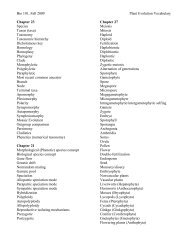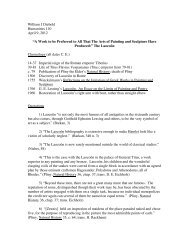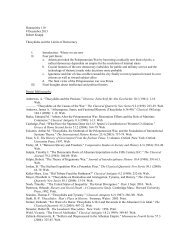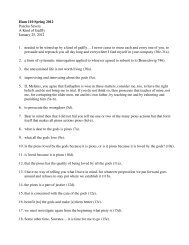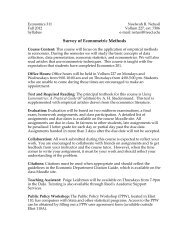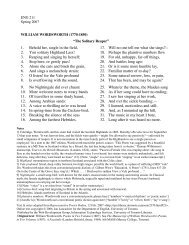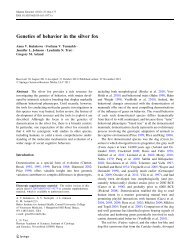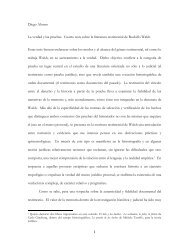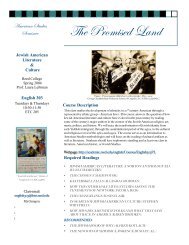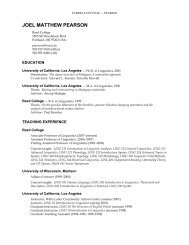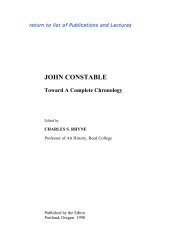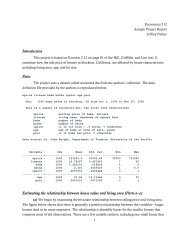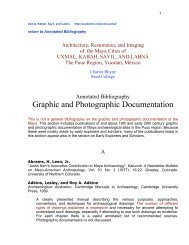REED COLLEGE SCIENCE OUTREACH PROPERTIES OF MATTER
REED COLLEGE SCIENCE OUTREACH PROPERTIES OF MATTER
REED COLLEGE SCIENCE OUTREACH PROPERTIES OF MATTER
You also want an ePaper? Increase the reach of your titles
YUMPU automatically turns print PDFs into web optimized ePapers that Google loves.
24<br />
2. Tell students that scientists use these physical and chemical properties to put matter into<br />
different groups. Grouping these substances helps to understand ways that chemicals are<br />
similar and different.<br />
As an example of how scientists might group items, you could have students help you<br />
group food items into food groups (fruits and vegetables, grains, proteins, dairy…).<br />
What do the items in each food group have in common?<br />
3. Tell students that scientists have special categories that they use to group chemicals. Two of<br />
the important groups are called acids and bases. Tell students that acids are substances like<br />
vinegar, lemon juice, and battery acid and that bases are substances like baking soda and many<br />
cleaning supplies. There are also some substances that are acids or bases (like water) and these<br />
are called neutral.<br />
4. Tell students that we are going to make a special exception today and we are going to get a<br />
chance to use our sense of taste to make some observations about acids.<br />
Ask for a few brave volunteers. Hand them each a packet of vinegar. Tell them to open it up and<br />
taste it. What does it taste like? Now hand them both a packet of lemon juice. What does it taste<br />
like?<br />
5. Tell the students that both of these substances are acidic. Students should conclude that<br />
acids taste sour. Tell students that it was ok for us to taste these substances since we know<br />
that they are safe. However, it wouldn’t be safe for us to try tasting everything to see if it was<br />
an acid or a base. For example, bases would taste bitter but most of them are also poisonous. It<br />
would be especially dangerous to taste really strong acids or basses because they are corrosive<br />
(will eat through substances like your skin).<br />
6. Tell students that instead of tasting everything, scientists have found another way to test to<br />
tell whether a substance is an acid or a base. They have special chemicals called indicators<br />
that will change colors when mixed with an acid or a base. Explain that many of these<br />
indicators are made from chemicals found in plants (such as the cabbage juice we are going to<br />
use today!).<br />
7. You will want to show the students the overhead showing the colors that cabbage juice will<br />
turn if it is an acid or a base. Point out that under each color is a number. Tell the students<br />
that these numbers are called the pH scale. Tell the students that it is a way that scientists<br />
describe how strong an acid or a base is (0=strong acid, 7=neutral, 14=strong base).<br />
pH Experiment (35-40 Minutes):<br />
8. Tell students that today their task will be to test a variety of substances that they might find<br />
around the house to determine which ones are acidic, basic, or neutral. Remind students that<br />
we WILL NOT taste these substances (they could be contaminated or even poisonous).<br />
Instead they will use cabbage juice as an indicator.<br />
9. Students will work in groups of 3-4 to test their substances. First pass out the gloves and<br />
goggles (Safety First!) and make sure that everyone puts on their safety equipment.<br />
10. Now you can start passing out the materials to each group, but tell them to wait for<br />
instructions before you start. Each group should have a cafeteria tray, a bottle of cabbage juice,<br />
vials of the test samples, and enough plastic cups/spoons for each sample.



